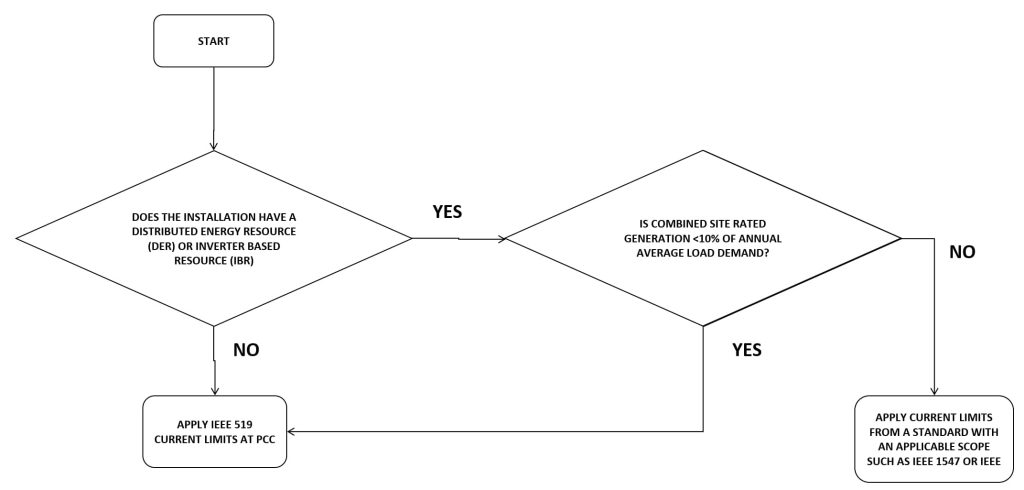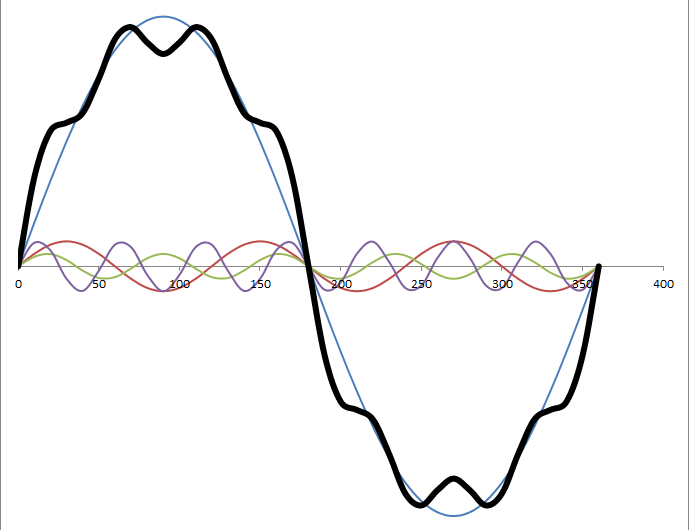Introduction
IEEE 519 Standard for Harmonic Control in Electric Power Systems is a highly recognized and referenced standard and has been updated in 2022. The purpose of the IEEE 519 is to establish goals for the design of electrical systems that include both linear and nonlinear loads.
Harmonics can cause two main problems—overheating and unwanted current—that can lead to disoperation of equipment, such as disturbances in telephone lines and communication networks. Specifically, harmonics can cause distortion of the supply voltage, equipment overheating, nuisance tripping of circuit breakers, and misfiring of variable speed drives. For this, IEEE 519-2022 specifies harmonic control.
Scope
This standard establishes goals for the design of electrical systems that include both linear and nonlinear loads. The voltage and current waveforms that may exist throughout the system are described, and waveform distortion goals for the system designer are established. The interface between sources and loads is described as the point of common coupling and observance of the design goals will reduce interference between electrical equipment. The voltage and current distortion limits in this standard shall apply at the user point of common coupling (PCC) to overall installation containing harmonic producing loads (nonlinear equipment). Users are directed to other applicable standards such as IEEE Std 1547 or IEEE Std 2800 for current distortion limits of inverter-based resources (IBR) installations. When no other applicable standard exists, users shall continue to use footnote “c” under Table 2 through Table 4 in this standard for IBR connected to transmission systems.
IEEE 519-2022 Standard for Harmonic Control in Electric Power Systems IEEE 519-2022 describes the voltage and current waveforms that exist throughout the system, specifies waveform distortion goals for the system designer, and details the interface between sources and loads. The voltage and current distortion limits in IEEE 519-2022 apply at the user point of common coupling (PCC) to overall installation containing harmonics.
Linear loads: Electrical loads that do not produce harmonic distortion (e.g., incandescent lamp, motors, and transformers).
Nonlinear loads: Electrical loads that produce harmonic distortion (e.g., fluorescent lamp, PC and TV, and printers).
Point of common coupling (PCC): The point on a public electrical power system that is connects to the utility’s electric system, such as the electric power revenue meter or premises service transformer. The PCC is a point located upstream of the considered installation.
Harmonics (harmonic components): Voltages or currents that are integer multiples of the fundamental power frequency, produced by the action of non-linear loads like rectifiers, discharge lighting, or saturated magnetic devices. IEEE 519-2022 defines harmonics as components of order greater than one of the Fourier series of a periodic quantity; for example, in a 60 Hz system, the harmonic order 3, also known as the “third harmonic,” is 180 Hz.”
What is the Purpose of Harmonic Voltage Distortion Limits?
Harmonic voltage distortion limits are provided to reduce the potential adverse effects on user and system equipment. IEEE 519-2022 specifies that maintaining harmonic voltages below objectionable levels necessitates the following:
Users limit their harmonic current emissions to reasonable values. Specifically, users should not add equipment that affects the impedance characteristic in a way that could increase voltage distortion, producing excessive voltage harmonic distortions.
Supply system owners or operators should control the system impedance characteristics to decrease voltage distortion when necessary.
Significant Changes
The significant changes in IEEE 519-2022 are:
1. The scope of IEEE 519-2022 has included Inverter-Based Resource (IBR) and/or Distributed Energy Resource (DER) installations which direct the user to IEEE Std 15471 or IEEE Std 28002 for current distortion limits if the combined site rated generation is ≥10% of the annual average load demand. A Decision Tree has been provided as Figure 1 in the standard to determine whether IEEE Std 519 current limits apply at the PCC.

2. Even-order harmonic current limits have been relaxed. Previously all even-order harmonics were limited to 25% of the individual harmonic limits as provided in the current limit tables. Now the current harmonic limits have been increased for even harmonics.
For h≤6 → Limits have increased from 25% to 50% of the individual limits shown in the tables.
For h>6 → Limits have increased from 25% to 100% of the individual limits shown in the tables.
Even-order harmonics are not desirable on power systems, and their appearance can indicate asymmetry between the positive and negative halves of the waveform. Perhaps it was felt that these increases were required due to the larger numbers of IBR, AFE drive and active filters, which may result in some levels of even order harmonics that may not have always been meeting the more stringent even-order harmonic limits in the previous 2014 standard.
3. Annex A. Significant changes to the Interharmonic Voltage Limits and Rationale. The standard mentions that more detail can be provided by referencing a paper by Drapela, et al [B3] "Issues and Challenges Related to Interharmonic Distortion Limits", 2020.3
Interharmonics can be difficult to address when dealing with active devices such as IBR, AFE Drives and active filters because they can often generate interharmonics. Passive filters typically treat harmonics over a frequency range so both harmonic and interharmonic frequencies are usually addressed.
The recommended limits (not prescriptive) are based on analysis of the sensitivity of lighting equipment (LEDs) to prevent flicker, and also more strict limits required on sensitive non-lighting equipment. Appropriate limits should be based on specific needs (local, country, conditions, etc.).
| ISC/IL | Individual harmonic limits. Harmonics values are in % of maximum demand load | TDD | |||||||||||
|---|---|---|---|---|---|---|---|---|---|---|---|---|---|
| 2 ≤ h < 6 | 6 ≤ h < 11 | 11 ≤ h < 17 | 17 ≤ h < 23 | 23 ≤ h < 35 | 35 ≤ h ≤ 50 | ||||||||
| Odd | Even | Odd | Even | Odd | Even | Odd | Even | Odd | Even | Odd | Even | ||
| <20 | 4.0 | 1.0 | 4.0 | 1.0 | 2.0 | 0.5 | 1.5 | 0.375 | 0.6 | 0.15 | 0.3 | 0.075 | 5.0 |
| 20<50 | 7.0 | 1.75 | 7.0 | 1.75 | 3.5 | 0.875 | 2.5 | 0.625 | 1.0 | 0.25 | 0.5 | 0.125 | 8.0 |
| 50<100 | 10.0 | 2.5 | 10.0 | 2.5 | 4.5 | 1.125 | 4.0 | 1.0 | 1.5 | 0.375 | 0.7 | 0.175 | 12.0 |
| 100<1000 | 12.0 | 3.0 | 12.0 | 3.0 | 5.5 | 1.375 | 5.0 | 1.25 | 2.0 | 0.5 | 1.0 | 0.25 | 15.0 |
| >1000 | 15.0 | 3.75 | 15.0 | 3.75 | 7.0 | 1.75 | 6.0 | 1.5 | 2.5 | 0.625 | 1.4 | 0.35 | 20.0 |
| ISC/IL | Individual harmonic limits. Harmonics values are in % of maximum demand load | TDD | |||||||||||
|---|---|---|---|---|---|---|---|---|---|---|---|---|---|
| Harmonic Limitsa, b | Harmonic Limitsa, b | Harmonic Limitsa, b | Harmonic Limitsa, b | Harmonic Limitsa, b | Harmonic Limitsa, b | ||||||||
| 2 ≤ h < 6 | 6 ≤ h < 11 | 11 ≤ h < 17 | 17 ≤ h < 23 | 23 ≤ h < 35 | 35 ≤ h ≤ 50 | ||||||||
| Odd | Even | Odd | Even | Odd | Even | Odd | Even | Odd | Even | Odd | Even | ||
| <20c | 4.0 | 2.0 | 4.0 | 4.0 | 2.0 | 2.0 | 1.5 | 1.5 | 0.6 | 0.6 | 0.3 | 0.3 | 5.0 | 20<50 | 7.0 | 3.5 | 7.0 | 7.0 | 3.5 | 3.5 | 2.5 | 2.5 | 1.0 | 1.0 | 0.5 | 0.5 | 8.0 |
| 50<100 | 10.0 | 5.0 | 10.0 | 10.0 | 4.5 | 4.5 | 4.0 | 4.0 | 1.5 | 1.5 | 0.7 | 0.7 | 12.0 |
| 100<1000 | 12.0 | 6.0 | 12.0 | 12.0 | 5.5 | 5.5 | 5.0 | 5.0 | 2.0 | 2.0 | 1.0 | 1.0 | 15.0 |
| >1000 | 15.0 | 7.5 | 15.0 | 15.0 | 7.0 | 7.0 | 6.0 | 6.0 | 2.5 | 2.5 | 1.4 | 1.4 | 20.0 |
|
a - For h≤ 6, even harmonics are limited to 50% of the harmonic limits shown in the table. b - Current distortions that result in a dc offset, e.g., half-wave converters, are not allowed c - Power generation facilities are limited to these values of current distortion, regardless of actual ISC/IL unless covered by other standards with applicable scope. Where: ISC - maximum short-circuit current at PCC IL - maximum demand load current at PCC under normal load operating conditions TDD - Total Demand Distortion |
|||||||||||||
References:
- IEEE Std 1547-2018, IEEE Standard for Interconnection and Interoperability of Distributed Energy Resources with Associated Electric Power Systems Interfaces.
- IEEE Std 2800-2022, IEEE Standard for Interconnection and Interoperability of Inverter-Based Resources (IBR) Interconnecting with Associated Transmission Electric Power Systems.
- Drapela, J., M. Halpin, R. Langella, J. Meyer, D. Mueller, H. Sharma, A. Testa, N. Watson and D. Zech, “Issues and Challenges Related to Interharmonic Distortion Limits,” 2020 19th International Conference on Harmonics and Quality of Power (ICHQP), Dubai, United Arab Emirates, 2020, pp. 1–6, doi: 10.1109/ICHQP46026.2020.9177933.
